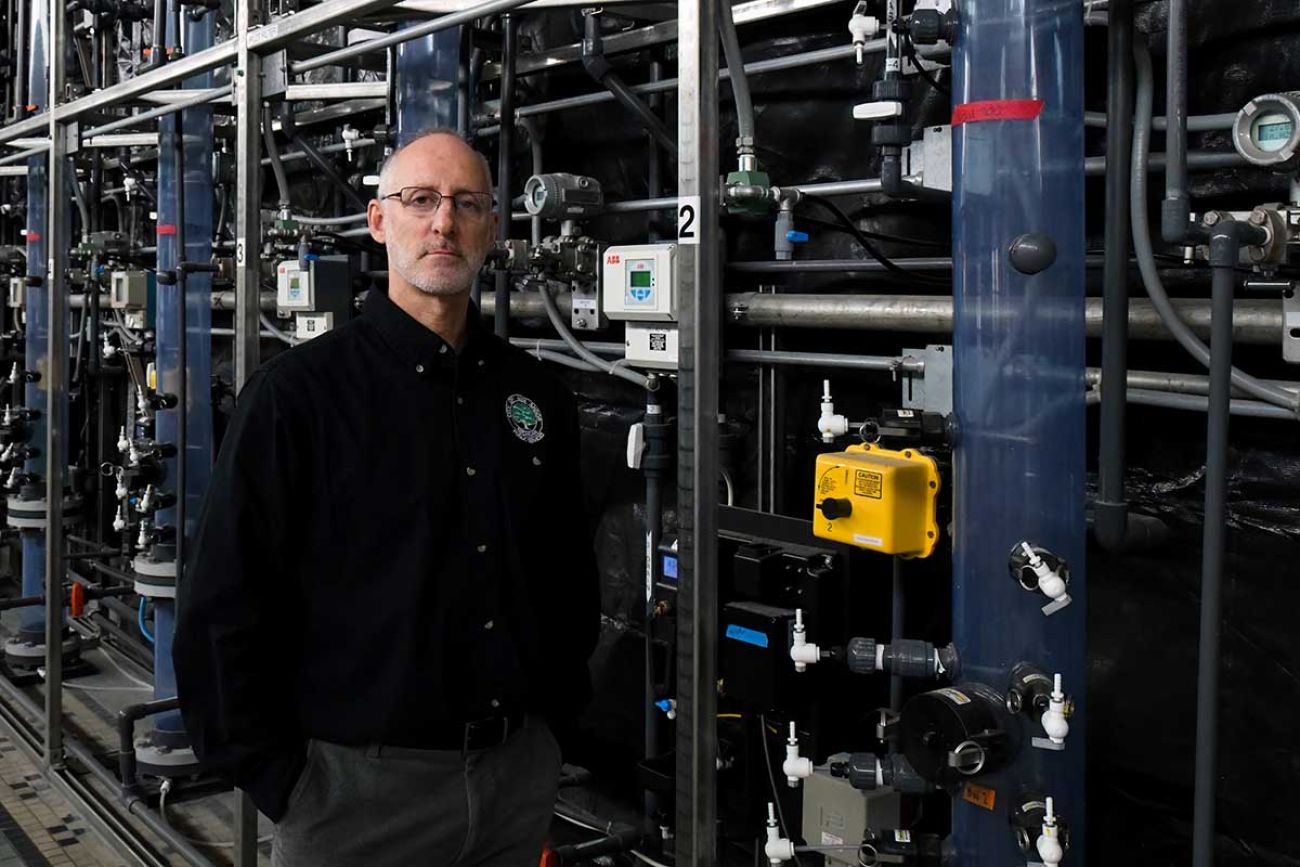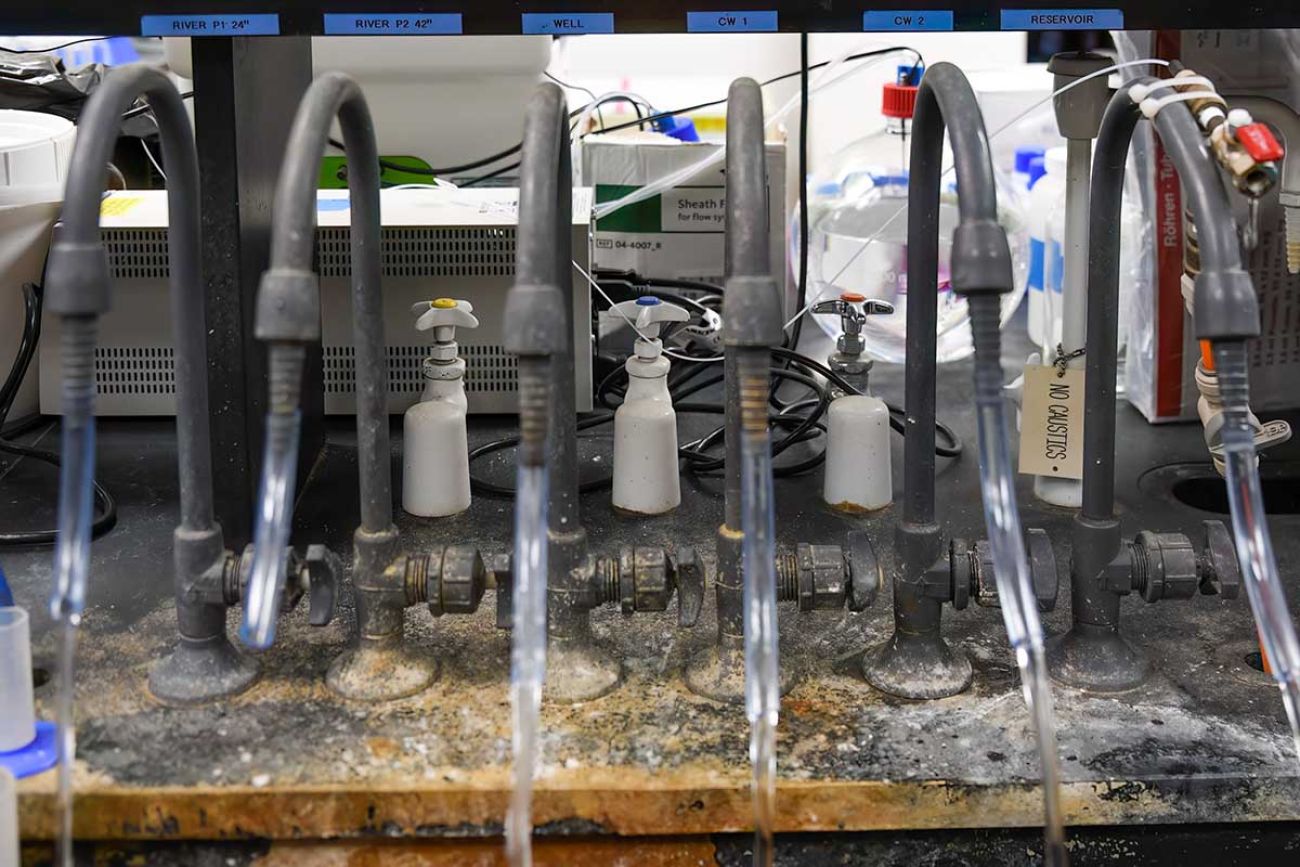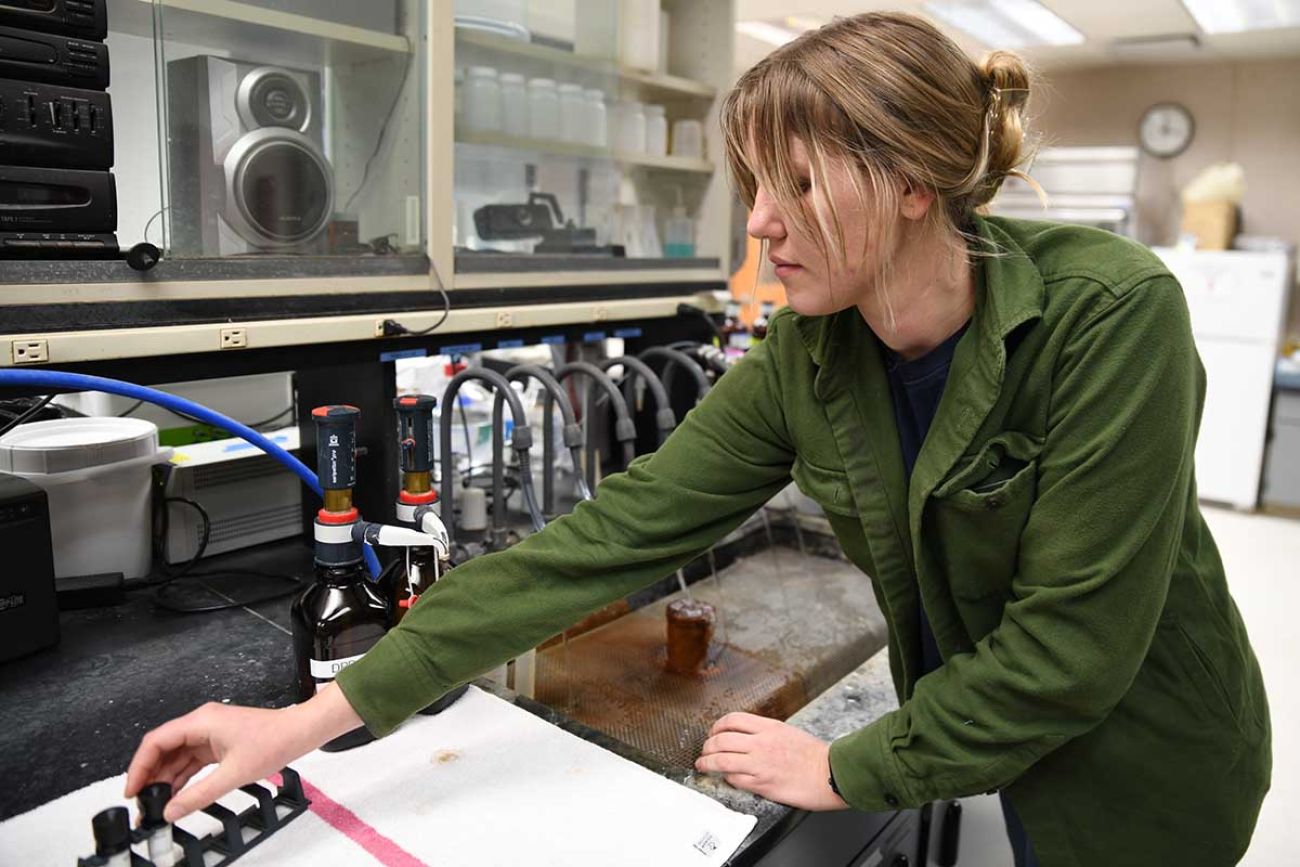For Ann Arbor water managers, ongoing battle to keep toxic chemicals at bay

- A growing array of contaminants threaten Michigan’s rivers, lakes and drinking water systems, and many of them are still unregulated
- Experts blame a federal system that’s too quick to approve new chemicals, and too slow to stop pollution when risks become clear
- Ann Arbor’s challenges illustrate the consequences
ANN ARBOR – Brian Steglitz and his staff had only recently gotten a handle on the last surprise contaminant to threaten Ann Arbor’s drinking water system when the call came in about another.
A plume of industrial wastewater, thought to be tainted with toxic hexavalent chromium, had entered the Huron River last August after spilling from a chrome-plating facility upstream. It was headed toward Ann Arbor’s intake pipes.
Though the heavy metal is toxic, federal and state drinking water standards say nothing about how much can safely enter public water supplies, and Ann Arbor’s water treatment plant, like most, was not set up to deal with it.
Related stories:

“We started looking at what our contingency plans are, you know?” said Steglitz, the city’s public services area administrator. “Like, if we're going to treat it, how do we do it? What happens if it gets there and we can't treat it?”
Steglitz and his crew would work nearly around-the-clock in the following days, mixing chemicals to identify a treatment mix that could remove chromium.
In the end, the crisis was averted: Most of the metal spilled from the plant, Tribar Manufacturing, had transformed into a more benign element before it reached the river. But the scare wasted city resources and left water customers on edge for weeks.
And it left Steglitz irritated that he and his staff have to spend so much energy reacting to chemical threats that compromise Ann Arbor’s drinking water.
“It's frustrating,” he said. “But you know, like, this is the world we live in.”
The Clean Water Act, a landmark federal pollution control law passed in 1972, cleaned up American waterways once fouled by industrial waste. But the act was focused largely on making rivers fishable and swimmable — not keeping them free of contaminants that can sully drinking water.
And it was written when the tests used to detect pollution in waterways were more rudimentary, and the public knew less about the perils of some substances that flow out of industrial waste pipes, seep off roads and lawns, or make their way into lakes and streams after being tossed in the trash.
Though testing capabilities and our knowledge of the risks have improved, regulations to protect America’s waterways, and ultimately its drinking water, from a range of troubling contaminants have been slow to follow. The result: a water safety system tilted more toward responding to toxic releases than trying to prevent them in the first place.
That leaves Ann Arbor — and similar communities across the country — to filter out pollution they didn’t cause in order to deliver safe water at the tap.
“The whole thing would be a lot cheaper,” said Bonnifer Ballard, executive director of the Michigan Section of the American Water Works Association, “if we just protected our source of water to begin with.”
Refresh
This story is part of a Great Lakes News Collaborative series investigating the region’s water pollution challenges. Called Refresh, the series explores the Clean Water Act’s shortcomings in the Great Lakes, and how the region can more completely address water pollution in the next 50 years.
The collaborative’s four newsrooms — Bridge Michigan, Circle of Blue, Great Lakes Now and Michigan Radio — are funded by the Charles Stewart Mott Foundation.
The PFAS crisis as a warning
The cost to Ann Arbor from the hexchrome scare was mostly in staff time as workers abandoned other duties to respond.
More financially quantifiable is Ann Arbor’s cost to respond to PFAS, another toxic chemical first detected by Ann Arbor in 2014 and later traced up the Huron River to the same chrome plating plant, Tribar. Since the discovery, Ann Arbor has spent $1.5 million upgrading its water system to strip away PFAS, and another $250,000 yearly on maintenance.
And then there’s money to prepare for the possibility of dioxane entering the city’s water supply — another pollutant not subject to drinking water regulations. Tainted groundwater is spreading from a property where the Gelman Sciences company used to manufacture medical filters, and inching toward Ann Arbor’s city-owned drinking water wells.
Communities across the country face similar threats from chemicals that industry discharged freely into waterways for decades before anyone became aware of the risks.
In the case of PFAS alone, a U.S. Government Accountability Office report in September found that one-in-five water systems across six states had unsafe levels of PFOA and PFOS. The chemicals also harm fish and wildlife in rivers, rendering the meat unsafe to eat.
And that’s to say nothing of other so-called “emerging contaminants,” from microplastics to pharmaceuticals, that are widespread and largely unregulated in U.S. waterways, and whose health and environmental impacts aren’t yet well-understood.
As Ann Arbor also prepares for a $100 million overhaul of its water treatment system, it is building a $2.5 million demonstration plant in hopes of being prepared for the next surprise threat. About the size of a modest house, the pilot plant will allow water operators to test new treatments to deal with existing water contamination problems and those that may arise in the future.
It's’ the right thing to do to protect the city’s residents, Steglitz says. But he would prefer that state and federal regulators move faster to identify threats to the city’s sourcewater, and then limit their release into the Huron River.
“Waiting for the EPA is just not going to be the solution any longer, because they’re just too slow,” he said.
Toxicologist Linda Birnbaum blames the nationwide struggle with emerging contaminants on the failings of three landmark federal environmental laws — the Clean Water Act, the Safe Drinking Water Act and the Toxic Substances Control Act — that are supposed to keep pollutants out of our environment.
Birnbaum, who headed the National Institute of Environmental Health Sciences, said EPA regulators working under those laws are too quick to approve chemicals for commercial use without studying the risks, and too slow to prevent releases into waterways when the risks become clear.
When enacted in 1972, the Clean Water Act promised to end pollution of America’s waterways by 1985. A half-century later, conditions have vastly improved in rivers once so fouled by industry, they occasionally caught fire. This was accomplished by requiring industries, public utilities and other so-called “point source” polluters to install technology that pulls certain pollutants from wastewater before they’re released into rivers.
But efforts to add new pollutants to the list haven’t kept pace with our growing understanding of the risks from substances that weren’t on regulators’ radar 50 years ago, including PFAS.
Meanwhile, a separate law, the Toxic Substances Control Act, tasks the EPA with reviewing the risks of new chemicals before they hit the market. Environmentalists have long complained that regulators are too quick to green light new chemicals.
Until recently, the EPA let the vast majority go to market with little vetting to confirm their safety. Reforms in 2016 required deeper reviews of tens of thousands of chemicals already in use, plus the new ones introduced each year. But companies frequently find exemptions, and EPA officials say staffing shortages make it impossible to keep pace as new chemicals are developed.
John Dulmes, executive director of the Michigan Chemistry Council, an industry group, criticized the 2016 reforms, saying they’ve “slowed the approval of new chemicals to a near-halt,” at times blocking innovation that has environmental benefits.
For example, U.S. Representatives Elissa Slotkin and Tim Walberg and Senators Gary Peters and Debbie Stabenow wrote to the EPA in April to complain that a slow-moving review process for carbon nanotubes needed to make battery cells could delay the opening of a new Lansing-area Ultium Cells plant.
Dulmes said those arguing for the regulatory system to take a slower, “precautionary” approach aren’t “appreciating the likely consequences for our economy.”
A third law, the Safe Drinking Water Act, dictates which substances drinking water providers must remove from water before the water can be distributed to customers. Here too, critics say, federal regulators have been slow to react to threats from new contaminants.
The three regulatory systems are not particularly well-aligned, said Birnbaum, who is also former director of the National Toxicology Program.
“When they were first set up in the ‘70s, I'm not sure we were as aware as we are today that everything is interconnected,” Birnbaum said.
PFAS, a class of thousands of persistent chemicals used in everything from nonstick coating to waterproof boots, is a prime example. Many PFAS compounds hit the market without any close study of their health effects. Companies like 3M continued to manufacture two PFAS compounds, PFOA and PFOS, long after internal studies revealed health concerns including cancer.
The EPA was aware of those concerns by the 1990s. Yet decades later, federal regulators still haven’t limited how much PFAS is allowed in rivers, lakes and drinking water, nor forced PFAS-using industries to filter the compounds out of their wastewater. In the interim, the toxic “forever chemicals” have made their way into waterways around the globe, and into the blood of nearly everyone on earth.
Despite numerous requests over more than a week, a spokesperson for the U.S. EPA failed to make someone available to speak with Bridge Michigan and Michigan Radio about the agency’s approach to approving new chemicals and managing the onslaught of water contamination from them.
EPA officials are drafting surface water and drinking water PFAS regulations, but it’s not clear when they’ll take effect.
Beset by PFAS contamination and frustrated by federal inaction, Michigan over the past decade has developed its own limits for a handful of PFAS compounds. But the lack of nationwide regulations leaves residents in many states unprotected, and compromises the shared water of the Great Lakes. Minnesota, Illinois, and Indiana, and Ohio lack enforceable drinking water standards, according to the national environmental health alliance Safer States.
“We have to start trying to look at a lifecycle approach,” Birnbaum said. That means establishing pollution control limits on chemicals as soon as they’re approved for use. Without such precautions, she said, “we seem always to be playing catch-up.”

Taking matters into state hands
Spooked by the PFAS crisis, the Michigan Department of Environment, Great Lakes and Energy is stepping up its own efforts to monitor for new contaminants. The goal is to spot troubling substances in Michigan’s waters before they cause another crisis.
“We needed a way, as a state, to be a little more nimble,” said Eric Oswald, director of EGLE’s Drinking Water and Environmental Health Division.
Likely candidates for monitoring include microplastics that can disrupt brain function and stunt growth in animals, hormone-disrupting pharmaceuticals, and the toxins found in harmful algae blooms that can damage the liver, nerves and skin. If water tests turn up concerning levels of a particular pollutant, Michigan may eventually consider new regulations to keep it out of water.
While the state gets its monitoring program underway, it is facing pressure from Ann Arbor to better contain contaminants already known to be a threat.
The city is sparring with state regulators over what it sees as disjointed regulations dictating how much PFAS the upstream city of Wixom (where Tribar is located) can discharge into the Huron River, and how much is allowed in the drinking water Ann Arbor draws from that very same river.
Out with the PFOS, in with the ‘next gen’
Michigan only requires wastewater treatment plants to limit discharges of three PFAS compounds. That includes at Wixom’s wastewater plant, which processes Tribar’s effluent.
By the time that water reaches Ann Arbor, though, the city must limit the presence of seven PFAS compounds in its drinking water. It monitors for 28.
“Why are Ann Arbor water customers responsible for dealing with these things when they can be dealt with at the source much more cost effectively?” Steglitz asked.
EGLE officials say a lack of good data leaves them powerless. The state can’t limit discharges of other PFAS compounds until scientists know how much exposure fish, wildlife and humans can safely withstand, said Phil Argiroff, assistant water resources director with the Michigan Department of Environment, Great Lakes and Energy.
In many cases, that kind of thorough health research doesn’t yet exist.
“Our toxicologists are always looking to get sufficient information to be able to establish water quality values for new” chemical compounds, Argiroff said.
Dulmes, of the Chemistry Council, pushed back against overregulation of chemicals like PFAS, noting that there are “extremely important” uses for some PFAS compounds, such as making semiconductors and lithium-ion batteries.
“These uses can be managed safely and responsibly,” he said.
Responding to Ann Arbor’s complaints, Wixom City Manager Steve Brown said the city operates its treatment plant in accordance with regulatory standards. And Tribar noted that it has stopped using PFOS-containing fume suppressants and installed carbon filters.
As for the hexchrome, the company has installed sensors and alarms, and created new spill prevention protocols. Some environmentalists are calling upon the state to ban chrome platers from using hexchrome.
Steglitz remains concerned.
Tribar didn’t stop using PFAS fume suppressants altogether — it simply switched to a different version called 6:2 FTS, one of many “next gen” compounds industry is deploying to replace legacy compounds like PFOS and PFOA. EGLE officials say Tribar’s carbon filtration system can’t remove 6:2 FTS as easily as it removes PFOS.
That and other PFAS compounds are now sometimes showing up in Ann Arbor’s water samples. Early research on the compound’s health impacts shows it may weaken the immune system.
“The short-sightedness on the front end? We're living with it on the back end for decades,” Steglitz said. “Because once these things get into the environment, they’re really hard to destroy.”
Michigan Environment Watch
Michigan Environment Watch examines how public policy, industry, and other factors interact with the state’s trove of natural resources.
- See full coverage
- Subscribe
- Share tips and questions with Bridge environment reporter Kelly House
Michigan Environment Watch is made possible by generous financial support from:
Our generous Environment Watch underwriters encourage Bridge Michigan readers to also support civic journalism by becoming Bridge members. Please consider joining today.
See what new members are saying about why they donated to Bridge Michigan:
- “In order for this information to be accurate and unbiased it must be underwritten by its readers, not by special interests.” - Larry S.
- “Not many other media sources report on the topics Bridge does.” - Susan B.
- “Your journalism is outstanding and rare these days.” - Mark S.
If you want to ensure the future of nonpartisan, nonprofit Michigan journalism, please become a member today. You, too, will be asked why you donated and maybe we'll feature your quote next time!






